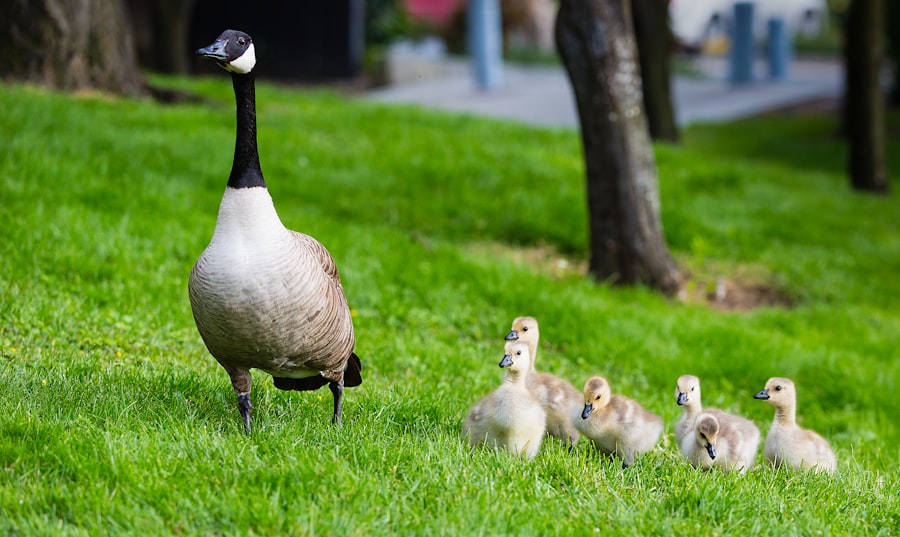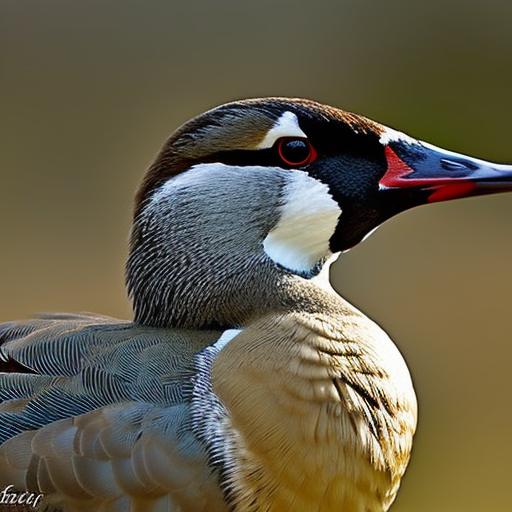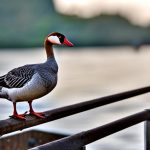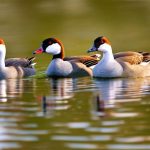Canadian geese overpopulation has become a significant problem in many areas across Canada. These birds are known for their aggressive behavior and their ability to cause damage to property and landscapes. It is essential to find humane and effective methods to control the geese population and prevent them from causing further harm. This article will explore various strategies for geese control, including understanding their behavior, implementing deterrent methods, creating physical barriers, utilizing sound and visual deterrents, installing motion-activated devices, maintaining a clean environment, seeking professional help, educating the community, following local regulations, and monitoring and evaluating prevention methods.
Key Takeaways
- Canadian geese are attracted to areas with water and open spaces for grazing
- Humane deterrent methods include using trained dogs or spraying non-toxic repellents
- Physical barriers such as fences or netting can prevent geese from entering certain areas
- Sound and visual deterrents like decoys or lasers can be effective in scaring off geese
- Motion-activated devices like sprinklers or noise makers can startle geese and encourage them to leave the area.
Understanding the behavior of Canadian geese
Canadian geese are migratory birds that are known for their distinctive honking sound and V-shaped flying formation. They are attracted to areas with open water, abundant food sources, and suitable nesting sites. These birds are highly adaptable and can thrive in both urban and rural environments. They are social animals that live in large flocks and exhibit aggressive behavior when they feel threatened or when protecting their nests.
To effectively control the geese population, it is crucial to understand their behavior and habits. By understanding what attracts geese to certain areas, we can implement strategies to make those areas less appealing to them. Geese are attracted to open grassy areas near water bodies, such as ponds, lakes, and rivers. They feed on grass, grains, and aquatic plants. They also prefer areas with minimal human disturbance and ample hiding spots.
Implementing humane deterrent methods
When it comes to geese control, it is essential to prioritize humane methods over harmful ones. There are several humane deterrent methods that can be used to discourage geese from settling in unwanted areas. These methods aim to make the environment less attractive to geese without causing them harm.
One effective method is habitat modification. By altering the landscape to make it less appealing to geese, we can discourage them from staying in the area. This can be done by reducing the amount of open grassy areas, removing or trimming vegetation near water bodies, and installing barriers to prevent geese from accessing certain areas.
Another humane method is the use of repellents. There are various non-toxic repellents available on the market that can be applied to grass and vegetation to deter geese from feeding. These repellents create an unpleasant taste or smell for the geese, making them seek food elsewhere.
Creating physical barriers to prevent geese from entering
Physical barriers are an effective way to prevent geese from entering certain areas. There are several types of physical barriers that can be used, depending on the specific needs and requirements of the location.
One common type of physical barrier is a fence or netting. These barriers can be installed around ponds, lawns, or other areas where geese are not welcome. The fence or netting should be at least three feet high to prevent geese from flying over it. It is important to regularly inspect and maintain the fence or netting to ensure its effectiveness.
Another type of physical barrier is a floating barrier. These barriers are placed in water bodies to prevent geese from accessing certain areas. Floating barriers can be made of ropes, buoys, or other materials that create a visible barrier for the geese.
Utilizing sound and visual deterrents
Sound and visual deterrents can be effective in deterring geese from settling in unwanted areas. These deterrents work by creating a sense of danger or discomfort for the geese, making them seek safer locations.
One common sound deterrent is the use of distress calls. These calls mimic the sounds made by distressed geese, signaling danger to other geese in the area. The distress calls can be played through speakers or other devices to create a sense of threat for the geese.
Visual deterrents can also be effective in deterring geese. These deterrents work by creating a visual barrier or by mimicking predators. One example of a visual deterrent is a scarecrow. Scarecrows can be placed in open areas to create a sense of danger for the geese. Other visual deterrents include reflective tape, balloons, and predator decoys.
Installing motion-activated devices to scare off geese

Motion-activated devices are another effective method for scaring off geese. These devices work by detecting the movement of geese and triggering a response that scares them away.
One example of a motion-activated device is a sprinkler system. These systems are equipped with motion sensors that detect the presence of geese and activate the sprinklers, creating a sudden burst of water that scares the geese away. Another example is a laser device that emits a laser beam when it detects movement, creating a visual deterrent for the geese.
Maintaining a clean and unattractive environment for geese
To discourage geese from settling in an area, it is important to maintain a clean and unattractive environment for them. Geese are attracted to areas with abundant food sources and suitable nesting sites. By removing these attractions, we can make the area less appealing to geese.
Regularly removing food sources, such as spilled grains or garbage, can help reduce the attractiveness of an area to geese. It is also important to remove or trim vegetation near water bodies to limit nesting opportunities for geese.
Seeking professional help for geese management
In some cases, it may be necessary to seek professional help for geese management. Professional geese management companies have the expertise and experience to effectively control the geese population and prevent further damage.
Professional companies can provide services such as habitat modification, installation of physical barriers, and implementation of deterrent methods. They can also provide ongoing monitoring and maintenance to ensure the effectiveness of the prevention methods.
Educating neighbors and community about geese control
Educating neighbors and community members about geese control is essential for long-term success. By raising awareness about the problem of geese overpopulation and the importance of prevention methods, we can encourage others to take action and implement these methods in their own properties.
One way to educate others is by organizing community workshops or seminars on geese control. These events can provide information on the behavior of geese, the impact of overpopulation, and effective prevention methods. It is also important to distribute educational materials, such as brochures or flyers, that provide tips and guidelines for geese control.
Following local regulations and laws regarding geese removal
When implementing geese control methods, it is crucial to follow local regulations and laws regarding geese removal. Different regions may have specific guidelines and restrictions on how geese can be managed.
It is important to consult with local authorities or wildlife agencies to ensure compliance with regulations. These agencies can provide information on permits, licenses, and other requirements for geese removal. By following the regulations and laws, we can ensure that our efforts to control the geese population are legal and ethical.
Monitoring and evaluating the effectiveness of geese prevention methods
Monitoring and evaluating the effectiveness of geese prevention methods is essential to determine their success and make any necessary adjustments. Regular monitoring allows us to assess whether the prevention methods are working as intended or if additional measures are needed.
One way to monitor the effectiveness of prevention methods is by conducting regular surveys or counts of the geese population in the area. This can help determine whether the population is decreasing or if there are any changes in behavior.
In conclusion, Canadian geese overpopulation is a significant problem that requires humane and effective solutions. By understanding the behavior of geese, implementing deterrent methods, creating physical barriers, utilizing sound and visual deterrents, installing motion-activated devices, maintaining a clean environment, seeking professional help, educating the community, following local regulations, and monitoring and evaluating prevention methods, we can effectively control the geese population and prevent further damage. It is important for individuals and communities to take action and implement these prevention methods to ensure a harmonious coexistence with Canadian geese.
If you’re looking for effective ways to keep Canadian geese off your property, you may find this article on “How to Deter Canadian Geese from Invading Your Space” helpful. It provides valuable insights and practical tips on how to discourage geese from nesting and roosting on your property. Additionally, if you’re interested in learning more about geese breeding habits, you might want to check out this related article on “What is the Incubation Period for Goose Eggs?” It offers detailed information on the incubation process and how long it takes for goose eggs to hatch naturally.
FAQs
What are Canadian geese?
Canadian geese are a species of waterfowl that are native to North America. They are known for their distinctive black heads and necks, white cheeks, and brown bodies.
Why do Canadian geese come onto my property?
Canadian geese are attracted to areas with open water, grassy areas, and low-lying vegetation. They may come onto your property to feed, rest, or nest.
Are Canadian geese protected by law?
Yes, Canadian geese are protected under the Migratory Bird Treaty Act, which makes it illegal to harm, capture, or kill them without a permit.
What are the risks of having Canadian geese on my property?
Canadian geese can cause damage to property, leave behind droppings that can be unsanitary and attract other pests, and pose a risk to human health due to the potential spread of diseases.
How can I keep Canadian geese off my property?
There are several methods for keeping Canadian geese off your property, including using visual deterrents, installing physical barriers, and modifying the landscape to make it less attractive to geese.
What are some visual deterrents for Canadian geese?
Visual deterrents for Canadian geese include scarecrows, reflective tape, balloons, and predator decoys.
What are some physical barriers for Canadian geese?
Physical barriers for Canadian geese include fences, netting, and hedges.
How can I modify my landscape to make it less attractive to Canadian geese?
Modifications to your landscape that can make it less attractive to Canadian geese include removing open water sources, reducing the amount of low-lying vegetation, and using landscaping materials that are less attractive to geese.
Meet Walter, the feathered-friend fanatic of Florida! Nestled in the sunshine state, Walter struts through life with his feathered companions, clucking his way to happiness. With a coop that’s fancier than a five-star hotel, he’s the Don Juan of the chicken world. When he’s not teaching his hens to do the cha-cha, you’ll find him in a heated debate with his prized rooster, Sir Clucks-a-Lot. Walter’s poultry passion is no yolk; he’s the sunny-side-up guy you never knew you needed in your flock of friends!







